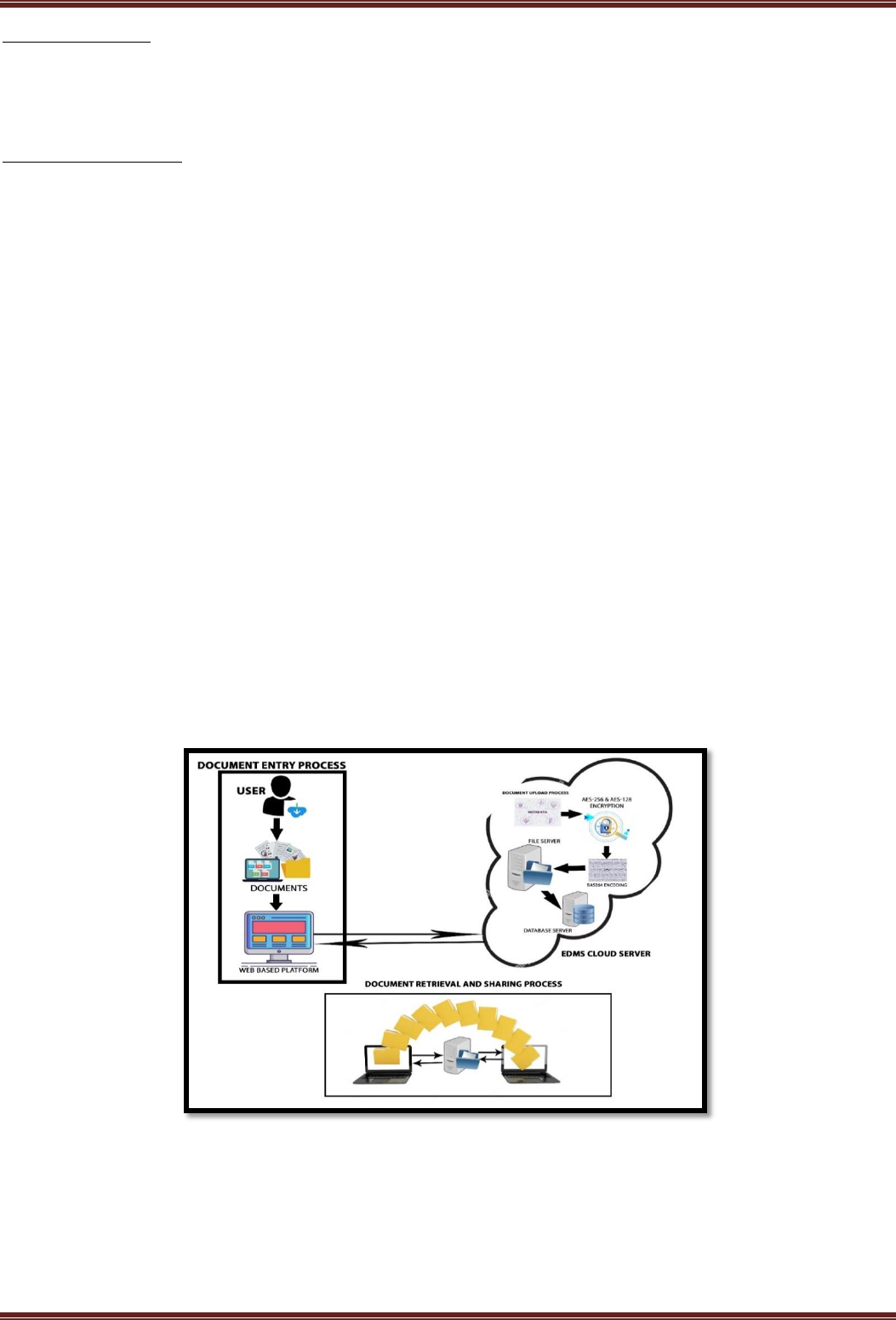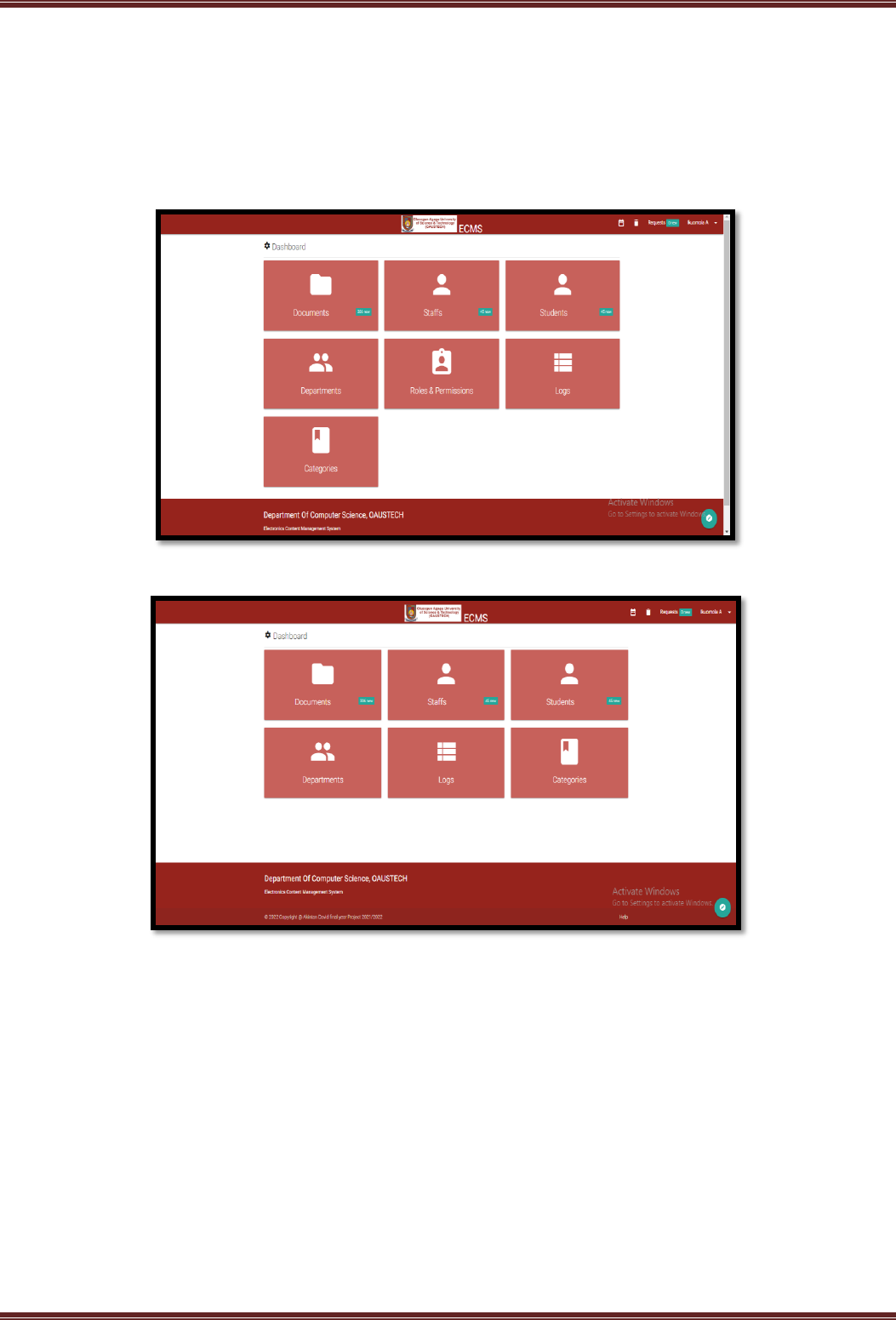
www.ijird.com December, 2022 Vol 11 Issue 12
INTERNATIONAL JOURNAL OF INNOVATIVE RESEARCH & DEVELOPMENT DOI No. : 10.24940/ijird/2022/v11/i12/DEC22010 Page 38
A Secured Cloud-Based Electronic Document
Management System
1. Introduction
According to Levien (1989), any information that is recorded and structured into a unit for the purpose of human
consumption is referred to as a document. Organizing and extracting documents/records from large volumes of physical
documents are very difficult. It is possible for documents to be misplaced or even get lost, and they are also prone to
human error (Akashah et al., 2011). Many years ago, organization documents were stored and managed on paper, usually
regarded as a manual approach, and this approach is characterized by lots of inefficiencies and work-related issues such as
high time consumption, errors, and redundancy during information collection, storage, and retrieval (Mehandjiev et al.
2013, Balogun, et al. 2019). Heckman (2008) was of the view that without the use of an efficient and effective document
management system, it is almost certain that the management of documents will always be prone to human error.
As students pass out each year from the institution, their records in the record department increase
tremendously. With the increase in the number and size of archives in the institution's records department, each file
contains approximately 200 documents in different sizes, and the slowness in dealing with the current archiving system,
increased costs, and the possibility of losing its contents and the paper document getting damaged makes it more
complicated to use. Furthermore, the increased volume of document production and distribution has aggravated problems
in document security, control, tracking, and retrieval.
Michalski (1991) argues that document processing by the use of technology has greatly transformed the role
played by documents in an organization from the very traditional paper-based record keeping to a more sophisticated and
complex content information processing and management that entail a wide variety of graphical, video, audio, animations,
images, processed for different organizational uses such as reports, contracts, handbooks, correspondences, memos, e-
mail, etc. in such a way that can be electronically generated, processed, stored, disseminated and displayed.
ISSN 2278 – 0211 (Online)
Ikuomola Aderonke Justina
Associate Professor, Department of Computer Science,
Olusegun Agagu University of Science and Technology, Okitipupa, Ondo State, Nigeria
Oyekan, Ezekiel Abiodun
Senior Lecturer, Department of Mathematical Sciences,
Olusegun Agagu University of Science and Technology, Okitipupa, Ondo State, Nigeria
Orogbemi, Olutomisin M.
Lecturer, Department of Computer Science,
Olusegun Agagu University of Science and Technology, Okitipupa, Ondo State, Nigeria
Abstract:
Documents stored and managed on paper are characterized by lots of inefficiencies and work-related issues such as
high time consumption, errors, and redundancy during information collection, storage, and retrieval. Producing
documents using computer-supported methods has become common practice in the institution but the management of
documents is still done with manual methods. It is also worth noting that the increased volume of document
production and distribution through e-mail systems and workstation-based file managers has aggravated problems in
document security, control, tracking, and retrieval. In this work, a secured cloud-based electronic document
management system was designed (SECEDOMAS). The system consists of three processes, namely:
The document entry process,
Electronic document management system (EDMS), and
Document retrieval and sharing process
The system was implemented using HTML, CSS, JavaScript, Laravel (PHP framework), and MySQL. An Advanced
Encryption Standard (AES) algorithm was used to encrypt the documents stored and shared to prevent the documents
from unauthorized users. The system was tested using the document of exams and records unit of Olusegun Agagu
University of Science and Technology, Okitipupa. The performance shows that it is effective in storing, retrieving, and
sharing processes. SECEDOMAS is well-structured, more efficient, secure, and durable.
Keywords: Cloud, electronic, document, management, security

www.ijird.com December, 2022 Vol 11 Issue 12
INTERNATIONAL JOURNAL OF INNOVATIVE RESEARCH & DEVELOPMENT DOI No. : 10.24940/ijird/2022/v11/i12/DEC22010 Page 39
Document management systems have been seen as the solution to many paper-related problems, and they seem
to offer the highest degree of control over the ways in which paper documents are handled. It should be noted that
document management systems manage documents and not the information or knowledge contained within the
documents (Yatin et al., 2015).
A lot of organizations/institutions have used paper files and folders for hundreds of years which had been part of
them. However, with the emphasis now on rendering services online using modern communications methods such as the
Internet and mobile phone-based services, this gives rise to the need for electronic document and records storage to
quickly and efficiently access whatever information is needed by the citizen (client) to deliver the services required
(Adam, 2008). Due to the dynamic nature of modern organizations that require enterprises to maintain electronic
documents to ensure interoperability of services, compete favorably, and share information seamlessly, it is necessary for
all organization-related information to be collected, stored, retrieved, and shared in a digital form (Mehandjiev et al.,
2013). Accordingly, it is also essential for organizations to access information as soon as possible to facilitate better
decision-making (Abaci, 2020).
Electronic Document Management System (EDMS) uses new information communication technology (ICT) to
process documents in such a way that public service performance and productivity are greatly enhanced. New advances in
this field have led to the development of more powerful EDMS with greater capabilities that transcend beyond the
traditional text-based document generation, printing, and distribution, to a more sophisticated and advanced computer-
based or knowledge-based information systems capable of eliciting, processing, analyzing, saving and disseminating
information in high communication speeds and presenting them in knowledgeable contexts useful to the user and
policymakers (Levien, 1989).
An EDMS provides many advantages including management support, budgetary, security, cooperation,
performance, privacy, and systems integration (Abdulkadhim et al., 2015). EDMS is an important element in establishing a
repository and transforming the capabilities of the organization and its workforce.
Nowadays, it is also worth noting that the increased volume of document production, publication, and corporate-
wide distribution through e-mail systems and workstation-based file managers has aggravated problems in document
security, control, tracking, and retrieval (Sutton, 1996). Likewise, storage systems are increasingly subject to attacks, so as
a result of this, data storage needs to be secure. For security purposes, cryptography techniques can be employed
(Kahanwal et al., 2012).
In a bid to address these pressing needs, a secured cloud-based electronic document management system was
developed. The system contains tools for converting paper documents into digital assets, organizing them in standardized
file structures and formats, and storing, securing, and accessing information by authorized workers. The new system is
easy to use, reliable, efficient, and more secure.
The work is organized as follows:
A brief overview of literature is given in section 2.
Section 3 provides a methodology for a secured cloud-based electronic management system.
The implementation and results are given in section 4.
Section 5 concludes the research work.
2. Literature Review
Gabrielaitis and Bausys (2006) developed a dynamic archive with information flows in both directions of the
design process chain that is consumer design archive. The design documentation is based on a reference model for an
Open Archival Information System (OAIS).
All the data are well-stored in the system, but there is no provision for document signatory/authentication; hence,
no security measure was put in place.
Park and Kim (2010) proposed a scrambling encryption technique in which a user (while issuing a registered e-
document to a third party) can send partial data of the document to prevent information leakage and improve document
readability. A hash function was used to change the values of image pixels to replace the image. Although the image files
are well-secured, the scrambling encrypting method employed in this system can only be used in low-specification mobile
devices, and the encryption techniques are targeted at image file format only.
Interpares 3 Project (2012) designed and implemented a record system for the entire organization considering
both paper and electronic records. In the first step, the functional software requirements are identified as both archival
and technological. The main archival requirements are registration, classification, and filling, retention and disposal,
security controls, search and retrieve, and elaboration of reports and statistics, while the main technological requirements
were related to application platforms, management of e-mails, formats, records and authentication and others such as
records transfer and export, remote work. Although the system preserved the institution's record with enduring valves,
there is no digital signatory on the document.
Kodmelwar et al. (2012) designed a document management system for small to medium-scale enterprises with a
special emphasis on security, and the system keeps track of the versions of a particular document over time.
Akor et al. (2013) investigated the role of assessing the record management of two Universities. In their work,
four (4) research questions were carried out. The population sample comprised staff from the establishment division of
the Universities, and the instrument used for data collection was a questionnaire. Frequency and percentages were used to
analyze the research question. The system has accurate and up-to-date information that ensures better service to the
communities, but it can lead to disastrous situations in the future.

www.ijird.com December, 2022 Vol 11 Issue 12
INTERNATIONAL JOURNAL OF INNOVATIVE RESEARCH & DEVELOPMENT DOI No. : 10.24940/ijird/2022/v11/i12/DEC22010 Page 40
Anwar and Ahmed (2013) proposed an e-Course file management system to shift from a current method of
compiling paper-based course files to a more versatile method of compiling and maintaining electronic course files. The
system reduces the human and financial resources needed for compiling course files, minimizes the negative
environmental impact, saves natural resources for future generations, and contributes towards a green sustainable
environment. However, the e-course files cannot be accessed or shared with other departments that are in need of it.
Mahmood and Okumus (2017) developed an electronic document management system that provides users in the
institution with a simple and efficient mechanism to access, manage and share their documents. However, this system does
not support e-mail and message facilities outside the system.
Rosa et al (2019) proposed a system that was used for managing and capturing both images and digital files of
scanned documents. The system has a mobile app that offers full mobile access and online support. Documents can be
accessed from any device that is internet enabled. The system lacks the convenience of a document management system
because documents need to be downloaded before they can be used, and it has only e-mail customer support and no phone
support.
Vilkov et al. (2019) considered a method for organizing product data and its basic tool for implementing a single
source in the form of a document management system. It involves processing a large amount of information, but the
information stored is not secured.
Odeh and Odeh (2019) proposed a system that will serve academic staff in organizing their course files and
provide many different functions related to management staff. The course file is accessible at any time and from anywhere,
but the signatory is carried out manually, and the system is not secure.
As a result of the challenges faced by the organization/institution, some limitations in the existing document
management approach, and the need to improve on it, a secured cloud-based electronic management system was
developed. The system can store and secure documents according to standardized compliance rules, share digital
documents with the right knowledge workers, and use a reliable, secure, and efficient database handling a large amount of
data.
3. Design Methodology
3.1. Design Consideration
The following are included in the system.
3.1.1. Security
This is an absolute necessity for any electronic document management system. A strict security system allows
authorized persons to perform the necessary duties. Before the file can be transferred, it must be encrypted for security
purposes. Likewise, document access is restricted to the authorized department (even within the organization) and for the
authorized employee/staff only.
3.1.2. Level of Abstraction
This feature ensures that document access is restricted to the authorized department (even within the
organization) and for the authorized employee only.
A staff working on a client machine will store and retrieve documents within their own directory stored inside the
department. The system allows a staff to access only their files and not of any other staff. Also, files from one particular
department will not be authorized for staff of the other department. Documents that are common to all departments will
be put in a common directory to which every staff has access.
3.1.3. Workflow Services
This feature of the system allows users to route files from worker to worker in an organized way which includes
the ability to prioritize the sending of files based on the sender-designated hierarchy order.
3.1.4. Signature and Comments Request
The system enables users to endorse signatures and make comments on the document before it is forwarded to
the intended users in the organization. The system keeps track of the files sent and forwards a copy of the document to the
sender's e-mail.
3.1.5. Data (File) Compression
This feature compresses the size of the encrypted file that resides on the server since the encrypted file has a
larger size than the plaintext file. Thus, compression allows us to optimize the size of the encrypted document. The system
uses the base64 compression technique as it gives us a fair ratio of the size of the data (file) and the time required to
compress it when compared with other popular compression techniques.
3.1.6. File Versioning
This feature of the system keeps track of the versions of a particular document over time. Staff working on a
particular document over a period of days may want to revert to a previous version of the same file. For this, the server
will keep multiple copies of the same file on it.

www.ijird.com December, 2022 Vol 11 Issue 12
INTERNATIONAL JOURNAL OF INNOVATIVE RESEARCH & DEVELOPMENT DOI No. : 10.24940/ijird/2022/v11/i12/DEC22010 Page 41
3.1.7. Data Recovery
This feature makes it possible to restore data that has been lost, accidentally deleted, corrupted, or made
inaccessible. Common causes of data loss include power outages, natural disasters, equipment failures or malfunctions,
accidental deletion of data, software crashes, and logical errors. However, this system takes care of these incidents and the
information about that file is stored in different places.
3.1.8. File Categorization
This feature of the system allows the users to assign file types and groups based on the criteria that they choose
and also separate them by folders and categories.
3.2. Architecture of a Secured Cloud-Based Electronic Document Management System
The architecture of a secured cloud-based electronic document management system (SECEDAMAS) is shown in
figure 1. The system comprises document entry process, Electronic Document Management System (EDMS), and document
retrieval and sharing process. The document entry process is made up of the document and the web-based interface. The
EDMS comprises the document upload process, search engine, security protocols, file server, database server, and DMS
server.
The document can either be internal or external. After the document has been created, the user goes online and
uploads the document through the web-based interface. During document uploading, the user needs to fill in some data
fields that provide the metadata or indexing tags (e.g., file name, folder name, document description) associated with the
specific document being uploaded, which will facilitate retrieval of the document. The user also assigns the user groups
that will have access rights (e.g., to view the document, add a new version, etc.) to the document. At this stage, naming the
document correctly using the correct naming convention is critical so that the document will be easy to retrieve after it is
uploaded.
The security protocol employed in the system is encryption and authentication. This system leveraged AES-256
and AES-128 encryptions provided by Laravel (a PHP framework), which provides us with a powerful encryption service.
It uses Open SSL for encryption and Base64 for encoding the files on the server. All the values included in Laravel are
signed using the protocol message authentication code so that the underlying value cannot be tampered with once
encrypted. The encrypted and encoded document/file is then stored in the file server. The file server, therefore, offers
users a central storage place for files on internal data media, which is accessible to all authorized users. The database
server is used to store system data and operate the entire system. The reason behind using this server is to increase
system security and archiving. The database comprises both the data sets and the database management system software
that manages and provides access to the data (back-end).
When documents are stored in the cloud, they are available for retrieval and sharing through the web-based
interface where users can search for documents using the search engine. The security settings determine if documents will
be made available to users (then the documents opened on the users' screens) and if the documents can be shared.
Figure 1: Architecture of Secured Cloud-Based Electronic Document
Management System (SECEDAMAS)
4. Implementation
SECEDOMAS was developed and implemented with Hypertext Markup Language (HTML), Cascading Style Sheets
(CSS), BOOTSTRAP, Laravel (PHP framework), JQuery, and MySQL (RDBMS).

www.ijird.com December, 2022 Vol 11 Issue 12
INTERNATIONAL JOURNAL OF INNOVATIVE RESEARCH & DEVELOPMENT DOI No. : 10.24940/ijird/2022/v11/i12/DEC22010 Page 42
4.1. Preliminary Testing of a Secured Cloud-Based Electronic Document Management System
It describes how the secured cloud-based electronic document management system was created and used. It
consists of different modules and interfaces for easy communication and usage.
The Admin Dashboard, shown in figure 2, is a page that is generated after a successful login by the Administration
having duly registered. It has all the menus that can be used to access all the systems functions and control all activities
within the system. While figure 3 shows the head of the department or unit dashboard. This is a page that is generated
after a successful login by the Head of Department (HOD) after due registration. It consists of the following menus:
departmental documents, staff, student, categories, and log functions.
Figure 2: Admin Dashboard
Figure 3: HOD Dashboard
In the process of uploading documents, the documents can be either internal or external. The internal document is
in the form of a softcopy which is created by system users, while the external document is in the form of a hard copy that
can be scanned and imported into the system.
Figure 4 shows the document scanning page where users are allowed to scan external documents (hardcopy)
directly from the scanner and upload the scanned document into the database, while figure 5 shows the file upload page,
which allows the users to upload the internal document (softcopy) into the system.

www.ijird.com December, 2022 Vol 11 Issue 12
INTERNATIONAL JOURNAL OF INNOVATIVE RESEARCH & DEVELOPMENT DOI No. : 10.24940/ijird/2022/v11/i12/DEC22010 Page 43
Figure 4: Document Scanning Page
Figure 5: File Upload Page
Document sharing is possible through the share file page, as shown in figure 6, where users can share information
with other users.
Figure 6: Share File Page
This work aimed at developing a secured cloud-based electronic document management system for Olusegun
Agagu University of Science and Technology, Okitipupa. The work solved the challenges faced by users with the current
method used. The benefits of using the developed application for the institution/organization include:
The system enables the generation of digital assets from paper documents
Provision of a robust database for archiving available documents in the institution.
Provision of timely access to information by management and authorized workers for quick decision making
Provision of low-cost technology for documentation
Generation of audit trails that automatically track exactly how information is being accessed for ongoing
regulatory compliance
Generation of check-in and check-out features to ensure information integrity and streamline collaboration

www.ijird.com December, 2022 Vol 11 Issue 12
INTERNATIONAL JOURNAL OF INNOVATIVE RESEARCH & DEVELOPMENT DOI No. : 10.24940/ijird/2022/v11/i12/DEC22010 Page 44
This work allowed the organization to uniquely secure documents and ensure that limited space is used. It makes
sure that only authorized users can gain access to services.
It provides an efficient mechanism to store, retrieve and share documents
It provides seamless sharing of documents between staff
The security pillars of the SECEDOMAS are:
4.1.1. Identification
This is a very important step for ensuring data confidentiality and isolation among many users. This is needed to
ensure that a specific user can only have access to their own data without interfering with any other users using the
application. When a user tries to access the application, the user identifier module looks up at the user's username and
password in the database. If it is found, then the user can have access to the application; otherwise, a 404-Not found HTTP
response is displayed.
4.1.2. Authentication
For the respective users of the application to have access to the dashboard or confidential information, users are
required to log in to the application with their staff id/e-mail and password.
4.1.3. Authorization
A Role Based Access Control (RBAC) system is built into this application to ensure that only users with specific
roles and permission can have access to protect resources or data.
4.1.4. Logging and Monitoring
Logging was built into the system to ensure that all errors or exceptions thrown during the use of the application
are stored to enable the administrator to keep track of what is working and not working in the system. This application
includes a monitoring feature that ensures that all actions carried out on the application and who was responsible for the
action are logged into the database. This is done to ensure easy traceability in case of misconduct or falsification of data.
4.1.5. Database Backup and Recovery
To ensure accessibility and continuity of information, data are backed up either daily, weekly, or monthly. So, in
case of data loss or the server is down, user data can easily be recovered and restored.
4.1.6. Rate Limiter
This module is used to ensure that no tenant is consuming the cloud resource by sending many requests to the
server. Hence rate limiter module was configured to ensure that, at any point user of the system can only send 60 HTTP
requests per second.
4.1.7. Encryption
Sensitive and highly confidential data, such as users' passwords, are not stored in plain text in the database but
are encrypted with powerful algorithms.
5. Conclusion
Moving from a traditional paperwork system to an electronic document management system helps educational
institutions to reduce costs, increase document security and minimize errors. A secured cloud-based electronic document
management system provides users in the institution with a simple and efficient mechanism to store, access, manage,
manipulate, synchronize and share their documents. It facilitates authentication to ensure that only authorized users gain
access to services. Finally, archiving in the system is performed by saving the document as a PDF file into the file server.
This functionality ensures data integrity and prevents data loss.
6. Acknowledgments
The authors would like to express their profound gratitude to the Referees for their valuable comments and
suggestions that helped the quality of this work.
7. Funding
This work was supported by the Tertiary Education Trust Fund (TetFund) through Institution-Based Research
Project (IBR).
8. References
i. Abaci K. (2020). Creation of Electronic Document Management Systems: A Research on Productivity in Public
Institutions. Ph.D. Thesis, Near East University, Graduate School of Social Sciences, Business Administration
Program.
ii. Abdulkadhim H., Bahari M., Bakri A., and Ismail W. (2015). A Research Framework of Electronic Document
Management Systems (EDMS) Implementatıon Process in Government. Journal of Theoretical and Applied
Information Technology, 81(3), 420.

www.ijird.com December, 2022 Vol 11 Issue 12
INTERNATIONAL JOURNAL OF INNOVATIVE RESEARCH & DEVELOPMENT DOI No. : 10.24940/ijird/2022/v11/i12/DEC22010 Page 45
iii. Adam A. (2008). Implementing Electronic Document and Record Management Systems. 1
st
edition, New York:
Auerbach Publications.
iv. Akashah P. A., Syamsul R., Jusoff K. & Christon E. (2011). Electronic Document Management System. World Applied
Sciences Journal (Special Issue on Computer Applications and Knowledge Management), 12: 55–58. Akor, P. U. (2013).
An Assessment of Record Management System in Establishment Division of Two Universities in Nigeria.
Mediterranean Journal of Social Sciences, 4(12), 87–96.
v. Anwar M. A. & Naseer A., (2013). An E-Course File Management System: A Green Campus Initiative. International
Journal of Information and Knowledge Management ISSN 2224-5758 (Paper) ISSN 2224–896X (Online).
vi. Balogun N. A., Raheem L. A., Abdulrahaman M. D. and Balogun U. O. (2019). Adaptability of Electronic Document
Management System in Ilorin Businesses, Nigerian Journal of Technology (NIJOTECH), 38(3), 707–715 Gabrielaitis L.
& Baušys R. (2006). Electronic document management in building design. Journal of Civil Engineering and
Management, Vol XII, No 2, 103–108.
vii. Heckman J., 2008. Why Document Management: A White Paper. Retrieved 13 February, 2010, from:
http://www.heckmanco.com/docs/DMWhitePaper.Pdf.
viii. Interpares 3 Project (2012). Design and implementation of a records management system at ICCROM: Final Report.
International Research on Permanent Authentic Records in Electronic Systems.
ix. Kahanwal B., Dua K. & Singh G. P. (2012). Java File Security System (JFSS). Global Journals Inc., 12: Version 1.0.
Kodmelwar M.K., Agarkar M., Borle Ajinkya, Deshmukh A., Bhagat M. (2012). Document Management System with
Enhanced Security. IOSR Journal of Computer Engineering (IOSRJCE), 1(2), 18–23.
x. Levien R.E. (1989). The Civilizing Currency: Document and Their Revolutionary Technologies’, Xerox Corporation,
Rochester. Mahmood A. & Okumus I. T. (2017). Design and Implementation of an Electronic Document Management
System. MAKÜ-Uyg. Bil. Derg., 1(1), 9–17.
xi. Mehandjiev N., Wajid U. & Namoun A. (2013) ‘Computers in Industry Designing and evaluating a system of
document recognition to support interoperability among collaborative enterprises,’ vol. 64, pp. 598–608.
xii. Michalski G. P. (1991): 'The World of Documents.' BYTE (April 1991): pp. 159–170, 1991.
xiii. Odeh A. H. & Odeh H. A. (2019). An Online Course File Management System (OCFMS). International Journal of
Simulation: Systems, Science and Technology. DOI: 10.5013/IJSSST.a.20.02.09
xiv. Park J. & Kim S. (2010). Design and Implementation of E-Document Encryption System using Hash Algorithm.
International Journal of Database Theory and Application, 3(3), 1–13.
xv. Rosa A.T.R., Pustokhina I. V., Lydia E. L., Shankar K., Huda M. (2019). Concept of Electronic Document Management
System (EDMS) as an Efficient Tool for Storing Documents, Journal of Critical Reviews, 6(5).
xvi. Vilkov V., Chernysh B. A., Kartamyshev A. S., Golovenkin E. N. & Poturemsky I. V. (2019) ‘The Document Management
System as an Integration Basis for Forming a Unified Data Source of Information Support of a Product Life-Cycle’
Journal of Physics: Conference Series doi:10.1088/1742-6596/1399/4/044099.
xvii. Yatin S. F. M., Ramli A.A.M., Shuhaimi H., Hashim H., Dollah W.K.W., Zaini M.K. & Abdul Kadir M.R. (2015). Electronic
Document Management System: Malaysian Experience, Australian Journal of Basic and Applied Sciences, 9(3)
Special 2015, 82–89.
